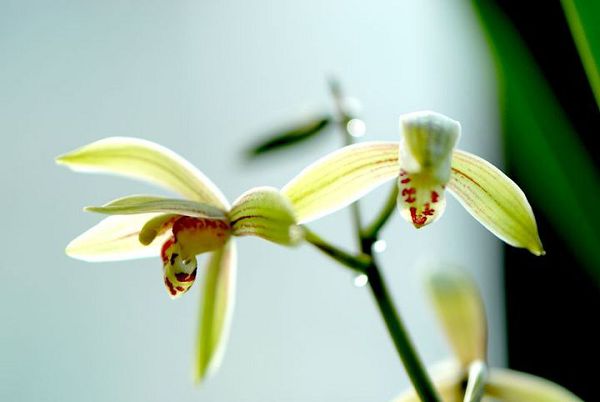Five key points of cultivation and Management of Cymbidium
Magnolia belongs to Amaryllidaceae, Orchidaceae, perennial evergreen herbaceous flowers. Its leaves are crisp, straight, elegant, dignified, natural and magnanimous. Foliage in four seasons, fruit in three seasons, flowers in one season do not bloom in the middle of summer and winter. Precious flowers with beautiful leaves, flowers and fruits have always been loved by flower lovers.
Most magnolia lovers like to grow at home, but in the maintenance process, there will be irregular leaves, rotten heart, flowering without fruit, hidden flowers or no flowering in the leaves, and so on. Want to let the gentleman orchid cultivated at home has a high ornamental value all the year round, the following points should be paid attention to in the process of cultivation.
1. Temperature: the suitable temperature for the growth of Cymbidium is 15-25 ℃. When the temperature is more than 30 ℃ in summer or lower than 5 ℃ in winter, the growth will be inhibited. Therefore, it is necessary to control the temperature so that the orchid can grow normally in winter and summer.
2. Humidity: when the growth process of Cymbidium is in the range of higher temperature, it needs higher air humidity to regulate the air temperature, and the humidity will increase with the increase of temperature in summer. Otherwise, the leaves will wilt due to drying, and the leaf color will become light and yellowing. But the humidity should not reach more than 90%, otherwise the leaves are very easy to become long and narrow, resulting in excessive growth symptoms.
3. Illumination: Cymbidium is a semi-negative plant, which likes to scatter light and avoid strong direct light. Indoor cultivation can generally meet its light needs, when the light is too strong, the green and glossy leaves will become dark green and lose luster, especially in summer, if shading measures are not taken in time, it will cause the leaves of Cymbidium to be dry, dull, and even lighter and yellowing. (note: in order to make the leaves of Cymbidium grow evenly and symmetrically, we should pay attention to turning the pot once a month. Turn 180 degrees from north to south.
4. Watering: Cymbidium should not be watered too often, and the amount of water required is also different in different periods. Spring and autumn is the growing season of Cymbidium should be timely watering, watering principle is thoroughly watered without leakage, high temperature in summer, Cymbidium is basically in a dormant state, to less watering to prevent rotting roots.
If the air is dry or the temperature is too high, indoor caregivers, due to air conditioning cooling, can be maintained normally, dry and wet watering can be seen; for example, in outdoor tree shade, in addition to dry and wet alternating watering, foliar spraying should be appropriate, or watering to maintain humidity and cooling. In winter, generally need indoor maintenance, at 5 ℃, the basin soil should be kept dry, dry and wet alternately; when the temperature is gradually adjusted to about 20 ℃, need to increase the number of watering, keep the basin soil slightly moist, because at this time is the bud flowering period, to ensure an adequate supply of water, in order to grow well.
5. Fertilization: the principle of fertilization of Cymbidium is that it is rather thin than thick, and the concentration of fertilizer will burn the roots and cause the leaves to scorch. Generally, the rotten and mature organic fertilizer will be applied in the spring and autumn, and the concentration is 15%, 20%, and once every 10-15 days. Watering once after applying liquid fertilizer, but the amount of water should not be too large, on the one hand, it can promote the dissolution of fertilizer, on the other hand, it can rinse the newly grown fleshy root to prevent liquid fertilizer injury.
The types of fertilization should be emphasized in different seasons. In general, some nitrogen fertilizer, such as bean cake water, should be applied in autumn to facilitate the growth of leaves, while in winter and spring, some phosphorus and potassium fertilizers, such as castor seeds, sesame seeds, bone meal, and so on, should be applied to facilitate the formation of leaf veins and the improvement of brightness. In addition, 0.1% potassium dihydrogen phosphate, calcium superphosphate or Huaduoduo can be sprayed on the leaf surface for extra-root topdressing, which can make the seedlings grow faster, draw more arrows, have large flowers and fruits.
Extra-root topdressing can be carried out all year round, especially in summer, foliage is often sprayed, which not only provides nourishment for the growth and development of Cymbidium, but also plays a cooling role; foliar wetting can also enhance photosynthesis and make Cymbidium thrive (fertilization can be stopped when the temperature is higher than 28 ℃ or lower than 10 ℃ in summer and winter.
Related
- Is the orchid suitable for indoor use? Is it good for the body?
- How to prevent the empty root of orchids?
- What to do after the crab claw orchid is withered?
- Why are the leaves of orchids always yellow? Fertilizing and watering.
- Can the root of the gentleman orchid be saved if it is rotten?
- Diagnosis and treatment of cotton-blowing beetle insects in Cymbidium
- There is a way for a gentleman's orchid to rot.
- What is the most suitable temperature and humidity for the orchid?
- How to raise a gentleman's orchid? Cultivation techniques of Cymbidium
- How to prepare the nutritive soil for the cultivation of Cymbidium



